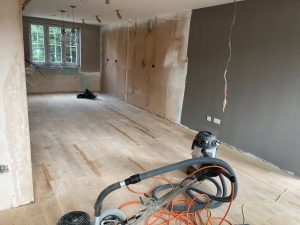Floor Sanding for Different Types of Wood: A Guide

Ensure the Best Results for Your London Home
Introduction
Wooden floors bring warmth and elegance to any home, but different types of wood require specific sanding techniques to achieve the best results. In this guide, we’ll explore the nuances of floor sanding for various types of wood commonly found in London homes. Whether you have hardwood, softwood, or exotic wood floors, understanding the right approach will help you maintain their beauty and durability.
Hardwood Floors
Hardwoods, such as oak, maple, and cherry, are popular for their durability and aesthetic appeal. Here are some tips for sanding hardwood floors:
- Choose the Right Grit Sequence: Start with a coarse grit (36-40) to remove old finishes and scratches. Progress to medium (60-80) and finish with fine grit (100-120) for a smooth surface.
- Use a Drum Sander: A drum sander is ideal for hardwood floors as it provides powerful sanding action. Be sure to keep it moving to avoid gouges.
- Handle with Care: Although hardwoods are durable, avoid excessive sanding to prevent thinning the wood too much.
Softwood Floors
Softwoods like pine, fir, and spruce are softer and can be more prone to dents and scratches. Here’s how to sand softwood floors:
- Start with a Finer Grit: Begin with a medium grit (50-60) to avoid creating deep scratches. Progress to finer grits (80-100) for a smooth finish.
- Use an Orbital Sander: Orbital sanders are gentler and better suited for softwoods. They reduce the risk of deep gouges and provide a more even finish.
- Inspect Frequently: Regularly check your progress to avoid over-sanding and damaging the wood.
Engineered Wood Floors

Engineered wood floors consist of a thin veneer of hardwood over plywood or high-density fiberboard. Sanding these floors requires special care:
- Limit Sanding Depth: Only sand engineered wood floors 1-2 times during their lifespan. Excessive sanding can wear through the veneer.
- Use Fine Grit Paper: Start with a fine grit (80-100) to minimize the removal of the veneer layer.
- Opt for a Professional: Due to the delicate nature of engineered wood, consider hiring professionals to ensure proper sanding without damage.
Exotic Wood Floors
Exotic woods like Brazilian cherry, teak, and mahogany are known for their unique colors and grain patterns. Sanding these woods requires attention to detail:
- Test for Hardness: Exotic woods can vary significantly in hardness. Test a small area to determine the appropriate grit sequence.
- Use Gradual Grit Progression: Start with a medium grit (50-60) and progress gradually to fine grit (100-120) to avoid damaging the intricate grain patterns.
- Maintain Consistency: Keep the sander moving consistently to avoid uneven sanding and maintain the wood’s natural beauty.
Parquet Floors
Parquet floors feature intricate patterns made from small wood pieces. Sanding parquet floors requires precision:
- Use an Orbital Sander: An orbital sander provides better control and reduces the risk of damaging the intricate patterns.
- Sand with the Grain: Follow the direction of the wood grain within each parquet piece to maintain the pattern’s integrity.
- Finish with Care: Apply finishes carefully to highlight the patterns without causing blotchiness.







The Impact of Floor Sanding on Home Value
The Impact of Floor Sanding on Home Value Enhance Your London Home’s Value with[Read more...]
The Best Floor Sanding Techniques for High-Traffic Areas
The Best Floor Sanding Techniques for High-Traffic Areas Maintaining the beauty and durability of[Read more...]
Eco-Friendly Floor Sanding: Sustainable Practices for Your Home
As environmental awareness continues to grow, many homeowners in London are seeking ways to make[Read more...]
The Best Finishing Techniques for Sanded Hardwood Floors
The Best Finishing Techniques for Sanded Hardwood Floors Hardwood floors are a timeless feature[Read more...]
The Role of Sealing in the Floor Sanding Process
The Role of Sealing in the Floor Sanding Process Enhancing the Durability and Appearance[Read more...]
The Importance of Professional Inspections Before Sanding
The Importance of Professional Inspections Before Sanding Ensure your London home is prepared for[Read more...]
How to Sand Floors in Small Spaces: Tips and Tricks
How to Sand Floors in Small Spaces: Tips and Tricks Sanding floors in[Read more...]
Floor Sanding and Allergies: Creating a Healthier Home
Living in a vibrant city like London offers many benefits, but it also means dealing[Read more...]
floorboard replacement
[Read more...]
The Importance of Ventilation During Floor Sanding
The Importance of Ventilation During Floor Sanding Expert Tips to Ensure a Safe and[Read more...]